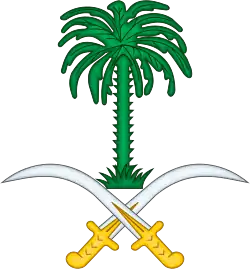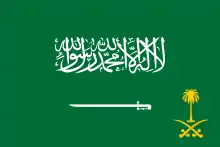Fahd of Saudi Arabia
Fahd bin Abdulaziz Al Saud (Arabic: فهد بن عبد العزيز آل سعود Fahd ibn ‘Abd al-‘Azīz Āl Sa‘ūd; 1921 or 1923 – 1 August 2005) was King of Saudi Arabia and Custodian of the Two Holy Mosques from 13 June 1982 to his death. He was one of 45 sons of Saudi founder Ibn Saud and the fourth of his six sons who were kings (Saud, Faisal, Khalid, Fahd, Abdullah and Salman).
| Fahd | |
|---|---|
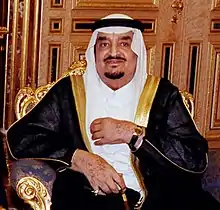 King Fahd in 1998 | |
| King of Saudi Arabia Prime Minister of Saudi Arabia Custodian of the Two Holy Mosques | |
| Reign | 13 June 1982 – 1 August 2005 |
| Bay'ah | 13 June 1982 |
| Predecessor | Khalid |
| Successor | Abdullah |
| Minister of Education | |
| In office | 1953–1962 |
| Predecessor | Office established |
| Successor | Abdulaziz ibn Abdullah Al ash-Sheikh |
| Monarch | Saud |
| Minister of Interior | |
| In office | 1962–1975 |
| Predecessor | Faisal bin Turki I bin Abdulaziz |
| Successor | Nayef bin Abdulaziz |
| Monarch | Saud Faisal |
| Born | 1921 or 1923 Riyadh, Sultanate of Nejd |
| Died | 1 August 2005 (aged 84) King Faisal Hospital, Riyadh |
| Burial | 2 August 2005 Al Oud cemetery, Riyadh |
| Issue | Faisal bin Fahd Khaled bin Fahd Muhammad bin Fahd Saud bin Fahd Sultan bin Fahd Abdul Aziz bin Fahd |
| House | House of Saud |
| Father | Ibn Saud |
| Mother | Hassa bint Ahmed Al Sudairi |
Fahd was appointed crown prince when his half-brother Khalid succeeded another half-brother King Faisal, who was assassinated in 1975. Fahd was viewed as the de facto prime minister during King Khalid's reign in part due to the latter's ill health. Fahd ascended to the throne on the death of King Khalid in 1982.
King Fahd is credited for having introduced the Basic Law of Saudi Arabia in 1992. He suffered a debilitating stroke in 1995, after which he was unable to continue performing his full official duties. Crown Prince Abdullah served as de facto regent of the kingdom and succeeded Fahd as king upon his death in 2005.
Early life and education

Fahd bin Abdulaziz was born in Riyadh in 1921[1] or 1923.[2][3][4] He was the eighth son of Ibn Saud.[5] His mother was Hassa Al Sudairi[6] and he was the eldest member of the Sudairi Seven.[7]
Fahd's education took place at the Princes' School in Riyadh, a school established by Ibn Saud specifically for the education of members of the House of Saud.[8] He received education for four years as a result of his mother's urging.[9] While at the Princes' School, Fahd studied under tutors including Sheikh Abdul-Ghani Khayat.[10] He then went on to receive education at the Religious Knowledge Institute in Mecca.[8][11]
Early political roles
Prince Fahd was made a member of the royal advisory board at his mother's urging.[12] In 1945, Prince Fahd traveled on his first state visit to San Francisco for the signing of the UN charter.[13] On this trip he served under his brother Prince Faisal, who was at the time Saudi Arabia's foreign minister.[11] Fahd led his first official state visit in 1953, attending the coronation of Queen Elizabeth II on behalf of the House of Saud.[10][14][15] On 24 December 1953, Prince Fahd was appointed education minister, being the first person holding this post in the country.[16][17]
Prince Fahd led the Saudi delegation to the League of Arab States in 1959, signifying his increasing prominence in the House of Saud—and that he was being groomed for a more significant role. In 1962, Fahd was given the important post of interior minister.[9] As interior minister he headed the Saudi delegation at a meeting of Arab Heads of State in Egypt in 1965.[11] On 2 January 1967 Prince Fahd survived an assassination attempt when an explosion occurred in his private office at the ministry.[18] He was not there during the incident, but the explosion injured nearly 40 staff of the ministry.[18]
At the beginning of King Faisal's reign Prince Fahd became a member of the council which had been established by the king to guide the succession issues.[19] He was named second deputy prime minister in 1967 which was created for the first time by King Faisal.[11][20] The post was created upon the request of then Crown Prince Khalid due to the fact that he himself did not want to continue to preside over the council of ministers.[21] King Faisal was not very enthusiastic about the appointment of Prince Fahd to the post.[21]
Crown Prince

After the death of King Faisal in 1975, Fahd was named first deputy prime minister and concurrently crown prince in 1975.[22][23] Although Prince Fahd had two elder brothers, Prince Nasser and Prince Saad, who had prior claims to the throne, both were considered unsuitable candidates.[22] By contrast, Prince Fahd had served as minister of education from 1954 to 1960 and minister of interior from 1962 to 1975.[22]
Appointment of Prince Fahd as both crown prince and first deputy prime minister made him a much more powerful figure in contrast to the status of King Khalid when he had been crown prince during King Faisal's reign.[24]
During this period Prince Fahd was one of the members of the inner family council which was led by King Khalid and included Prince Mohammed, Prince Abdullah, Prince Sultan and Prince Abdul Muhsin as well as two of his surviving uncles, Prince Ahmed and Prince Musaid.[25]
Reign
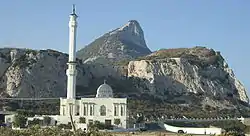
When King Khalid died on 13 June 1982, Fahd succeeded to the throne[26] being the fifth king of Saudi Arabia.[27] However, the most active period of his life was not his reign, but when he was Crown Prince.[28] He adopted the title "Custodian of the Two Holy Mosques" in 1986, replacing "His Majesty", to signify an Islamic rather than secular authority.[11]
Foreign policy
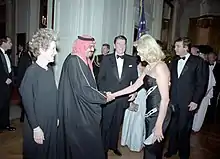
Fearing that the 1979 Iranian Revolution could lead to similar Islamic upheaval in Saudi Arabia, Fahd spent considerable sums, after ascending the throne in 1982, to support Saddam Hussein's Iraq in its war with Iran.[29] In fact, according to United States Secretary of State Alexander Haig, Fahd told Haig in April 1981 that he had been used as an intermediary by President Jimmy Carter to convey an official U.S. "green light to launch the war against Iran" to Iraq, although there is considerable skepticism about this claim.[30][31]
Fahd was a supporter of the United Nations. He supported foreign aid and gave 5.5% of Saudi Arabia's national income through various funds especially the Saudi Fund for Development and the OPEC Fund for International Development. He also gave aid to foreign groups such as the Bosnian Muslims in the Yugoslav Wars, as well as the Nicaraguan Contras, providing "a million dollars per month from May to December 1984".[32] King Fahd was also a strong supporter of the Palestinian cause and an opponent of the State of Israel.[33] Fahd was a staunch ally of the United States, and has been quoted by the CIA as saying, "After Allah, we can count on the United States."[34] He did however at times distance himself from the US, declining to allow US to use Saudi airbases to protect naval convoys after the attack on the USS Stark, and in 1988 agreed to buy between fifty and sixty nuclear-payload-capable CSS-2 intermediate-range ballistic missiles.[35]
King Fahd developed a peace plan in order to resolve Arab differences particularly between Algeria and Morocco.[36][37] He also actively contributed to the Taif accord in 1989 that ended conflict in Lebanon.[17][36] In addition, he led the Arab world against the invasion of Kuwait by Iraq.[36] He developed a special bond with both Syrian President Hafez Assad and Egyptian President Hosni Mobarak during his reign.[38]
Islamic activities
He took steps to support the conservative Saudi religious establishment, including spending millions of dollars on religious education,[39] strengthened separation of the sexes and power of the religious police, publicly endorsed Sheikh Abd al-Aziz ibn Baz's warning to young Saudis to avoid the path of evil by not travelling to Europe and the United States.[40] This further distanced him from his inconvenient past.[39]
Gulf War, 1991
In 1990, Iraqi forces under Saddam Hussein invaded Kuwait, placing the Iraqi army (then the largest in the Middle East) on the Saudi-Kuwaiti border. King Fahd agreed to host American-led coalition troops in his Kingdom, and later allowed American troops to be based there.[41] This decision brought him considerable criticism and opposition from many Saudi citizens, who objected to the presence of foreign troops on Saudi soil;[42] this was a casus belli against the Saudi royal family prominently cited by Osama bin Laden and Al Qaeda. His decision was also objected to by his full brothers or the Sudairi Seven.[41] Another cause for criticism came when during an event with the British Royal Family, King Fahd was seen wearing a white decoration in the shape of a cross; in 1994 Bin Laden cited this as "abomination" and "clearly infidelity".[43]
Reform and industrialization
In regard to reform, King Fahd showed little tolerance for reformists. In 1992, a group of reformists and prominent Saudi intellectuals petitioned King Fahd for wide-ranging reforms, including widening political representation, and curbing the royal family's wasteful spending. King Fahd first responded by ignoring their requests and when they persisted, reformists were harshly persecuted, imprisoned and fired from their jobs.
During King Fahd's rule, the royal family's lavish spending of the country's wealth reached its height. In addition, the biggest and most controversial military contract of the century, the Al-Yamamah arms deal was signed on his watch.[44] The contract has cost the Saudi treasury more than $90 billion. These funds were originally allocated to building hospitals, schools, universities and roads. As a result, Saudi Arabia endured a stagnation in infrastructure development from 1986 till 1999 when the new King, Abdullah, fully came into power.
Like all the countries bordering the Persian Gulf, Saudi Arabia under King Fahd has focused its industrial development on hydrocarbon installations. Up to this day, the country is reliant on imports for nearly all its light and heavy machinery.
King Fahd established a Supreme Council of Islamic Affairs directed by senior family members and technocrats in 1994. The council was planned to function as an ombudsman of Islamic activity concerning educational, economic and foreign policy matters. The chairman of the council was Prince Sultan]. Prince Nayef, Prince Saud and a technocrat Mohammed Ali Aba al Khail were appointed to the newly established council. One of the covert purposes of the council was thought to be to reduce the power of the Ulemas Council had been increasing its power.[45]
Succession mechanism
In an effort to institutionalize succession King Fahd issued a decree on 1 March 1992.[46] The decree expanded the criteria for succession, which had been only seniority and family consensus, and led to speculations.[46] The most significant change by the edict was that the King did acquire the right to appoint or dismiss his heir apparent based on suitability rather than seniority and that the grandsons of Abdulaziz became eligible for the throne.[46]
Rule after the 1995 stroke
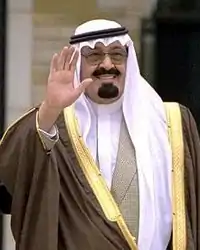
King Fahd was a heavy smoker, overweight for much of his adult life, and in his sixties began to suffer from arthritis and severe diabetes.[7] He suffered a debilitating stroke on 29 November 1995[17] and became noticeably frail, and decided to delegate the running of the Kingdom to Crown Prince Abdullah on 2 January 1996.[42][46][47] On 21 February, King Fahd resumed official duties.[48]
After his stroke King Fahd was partly inactive and had to use a cane and then a wheelchair,[49] though he still attended meetings and received selected visitors. In November 2003, according to government media, King Fahd was quoted as saying to "strike with an iron fist" at terrorists after deadly bombings in Saudi Arabia, although he could hardly utter a word because of his deteriorating health. However, it was Crown Prince Abdullah who took official trips; when King Fahd traveled it was for vacations, and he was sometimes absent from Saudi Arabia for months at a time. When his oldest son and International Olympic Committee member Prince Faisal bin Fahd died in 1999, the King was in Spain and did not return for the funeral.[50]
In a speech to an Islamic conference on 30 August 2003, King Fahd condemned terrorism and exhorted Muslim clerics to emphasize peace, security, cooperation, justice, and tolerance in their sermons.[51]
Wealth
Forbes estimated Fahd's wealth to be $25 billion in 2002,[52] Fortune Magazine reported his wealth in 1988 at $18 billion (making him the second richest person in the world at that time).[53] In addition to residences in Saudi Arabia he had a palace on Spain's Costa del Sol which made Marbella a famous place.[54]
Recreational activities
At the same time as King Fahd presided over a more strict Islamic policy at home he was known to enjoy luxurious living abroad, even in ways that would not be allowed in his own kingdom. He visited the ports of the French Riviera, in his 147-metre (482 ft) yacht, the $US100 million Abdul Aziz. The ship featured two swimming pools, a ballroom, a gym, a theatre, a portable garden, a hospital with an intensive-care unit and two operating rooms, and four American Stinger missiles.[55] The king also had a personal $US150 million Boeing 747 jet, equipped with his own fountain. In his visits to London he reportedly lost millions of dollars in the casinos and was even known to circumvent the curfew imposed by British gaming laws by hiring his own blackjack and roulette dealers to continue gambling through the night in his hotel suite.[56]
Personal life
King Fahd was married at least thirteen times. The spouses of King Fahd were as follows:
- Al Anood bint Abdulaziz bin Musaid Al Saud (Deceased), mother of his eldest five sons, Prince Faisal, Prince Mohammed, Prince Saud, Prince Sultan and Prince Khalid.[57][58][59]
- Al Jawhara bint Ibrahim Al Ibrahim, mother of Prince Abdulaziz bin Fahd
- Jawza bint Abdallah bin Abdul Rahman Al Saud (Divorced)[60]
- Al Jowhara bint Abdullah Al Sudairi (Deceased)
- Modhi bint Turki bin Abdullah Al Saud (Divorced)
- Joza'a bint Sultan Al Adgham Al Subaie (Divorced)
- Turfa bint Abdulaziz bin Mo'amar (Divorced)
- Watfa bint Obaid bin Ali Al Jabr Al Rasheed (Divorced)
- Lolwa al Abdulrahman al Muhana Aba al Khail (Divorced)
- Fatmah bint Abdullah bin Abdulrahman Aldakhil
- Shaikha bint Turki bin Mariq Al Thit (Divorced)
- Seeta bint Ghunaim bin Sunaitan Abu Thnain (Divorced)
- Janan Harb (Widowed)[61]
King Fahd had six sons and four daughters.[9] His sons are:
- Faisal bin Fahd (1945–1999) Died of a heart attack. Director-general of Youth Welfare (1971–1999), director-general at ministry of planning and minister of state (1977–1999)
- Muhammad bin Fahd (born January 1950), former governor of the Eastern province
- Saud bin Fahd (born 8 October 1950), former deputy president of the General Intelligence Directorate[62]
- Sultan bin Fahd (born 1951), army officer. Elevated to ministerial rank in November 1997. Former head of Youth Welfare
- Khalid bin Fahd (born February 1958)[62]
- Abdulaziz bin Fahd, (born 16 April 1973), Fahd's favourite and youngest son and minister of state without portfolio. He is the son of Princess Jawhara Al Ibrahim, Fahd's fourth and, reportedly, favourite wife.[63]
One of his daughters, Latifa bint Fahd, died at age 54 in Geneva in late December 2013.[64][65] Al Jawhara bint Fahd who was another daughter of him and wife of Turki bin Mohammad bin Saud Al Kabeer died in June 2016.[66]
Death
King Fahd was admitted to the King Faisal Specialist Hospital in Riyadh on 27 May 2005 for unspecified medical tests.[67] An official (who insisted on anonymity) told the Associated Press unofficially that the king had died at 07:30 on 1 August 2005. King Fahd was 84.[68] Official statement was announced on state television at 10:00 by then information minister Iyad Madani.[68]
Funeral
King Fahd was buried in the last thawb (traditional Arab robe) he wore. Fahd's body was carried to Imam Turki bin Abdullah Mosque, and funeral prayers were held at around 15:30 local time (12:30 GMT) on 2 August.[68] The prayers for the late monarch were led by the Kingdom's grand mufti, Sheikh Abdul Aziz Al Sheikh.
The "funeral prayer", during which worshipers remain standing, was performed after afternoon prayers. The ceremony was replicated in other mosques across the Kingdom, where the "prayers for the absentee" were held.
The body was carried by King Fahd's son, Abdul Aziz bin Fahd to the mosque and to the Al Oud cemetery some two kilometres away, a public cemetery where Fahd's four predecessors and other members of the Al Saud ruling family are buried.[69][70]
Arab and Muslim dignitaries who attended the funeral were not present at the burial. Only ruling family members and Saudi citizens were on hand as the body was lowered into the grave.
Muslim leaders offered condolences at the mosque, while other foreign dignitaries and leaders who came after the funeral paid their respects at the royal court.
In accordance with regulations and social traditions, Saudi Arabia declared a national mourning period of three days during which all offices were closed. Government offices remained closed for the rest of the week.[68] The state flag was not lowered (since the flag of Saudi Arabia bears the Shahada, the Islamic declaration of faith, the flag's protocol requires the flag not to be lowered)
After his death, many Arab countries declared mourning periods.[8] Algeria, Egypt, Iraq, Kuwait, Lebanon, Morocco, Oman, Qatar, Syria, Yemen, the Arab League in Cairo, and the Palestinian Authority all declared three-day mourning periods.[8] Pakistan and the United Arab Emirates declared a seven-day mourning period and ordered all flags flown at half-staff.[71] In Jordan, a national three-day mourning period was declared and a 40-day mourning period was decreed at the Royal Court.
Many foreign dignitaries attended the funeral, such as US Vice President Dick Cheney, French President Jacques Chirac, King Juan Carlos of Spain, Prince Charles of the United Kingdom, Sultan Hassanal Bolkiah of Brunei Darussalam, Pakistan President Pervez Musharraf, King Abdullah II of Jordan, Palestinian President Mahmoud Abbas, Singapore President of Singapore S.R. Nathan, and President of Mauritania Maaouya Ould Sid'Ahmed Taya (under deposition).
Honours
Foreign honours
 Spain : Collar of the Order of Civil Merit (1977)[72]
Spain : Collar of the Order of Civil Merit (1977)[72]
- Grand Cross of the Order of Civil Merit (1977)[73]
 Malaysia : Honorary Grand Commander of the Order of the Defender of the Realm (1982)[74]
Malaysia : Honorary Grand Commander of the Order of the Defender of the Realm (1982)[74] United Kingdom : Royal Victorian Chain.[75][76]
United Kingdom : Royal Victorian Chain.[75][76]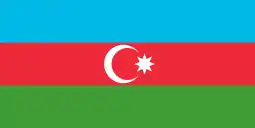 Azerbaijan : Istiglal Order (7 March 2005)[77]
Azerbaijan : Istiglal Order (7 March 2005)[77]
In 1984, King Fahd received the Faisal Prize for Service to Islam awarded by the King Faisal Foundation.[78]
Ancestry
| Ancestors of Fahd of Saudi Arabia[60] | |||||||||||||||||||||||||||||||||||||||||||||||||||||||||||||||||||||||||||||||||||||||||||||||||||||||||||||||||||||||||||||||||||||||||||||||||||||||||||||||||||||||||||||||||||||||||||||||||||||||||||||||||||||||||||||||||||||||||||||||||||||||||||||||||||||||||||||||||||||||||||||||||||||||||||||||||||||||||||||||||||||||||||||||||||||||||||||||||||||||||||||||||||||||||||||||||||||||||||||||||||||||||||||||||||||||||||||||||||||||||||||||||||||||||||||||||||||||||||||||||||||||||||||||||||||||||||||||||||||||||||||||||||||||||||||
|---|---|---|---|---|---|---|---|---|---|---|---|---|---|---|---|---|---|---|---|---|---|---|---|---|---|---|---|---|---|---|---|---|---|---|---|---|---|---|---|---|---|---|---|---|---|---|---|---|---|---|---|---|---|---|---|---|---|---|---|---|---|---|---|---|---|---|---|---|---|---|---|---|---|---|---|---|---|---|---|---|---|---|---|---|---|---|---|---|---|---|---|---|---|---|---|---|---|---|---|---|---|---|---|---|---|---|---|---|---|---|---|---|---|---|---|---|---|---|---|---|---|---|---|---|---|---|---|---|---|---|---|---|---|---|---|---|---|---|---|---|---|---|---|---|---|---|---|---|---|---|---|---|---|---|---|---|---|---|---|---|---|---|---|---|---|---|---|---|---|---|---|---|---|---|---|---|---|---|---|---|---|---|---|---|---|---|---|---|---|---|---|---|---|---|---|---|---|---|---|---|---|---|---|---|---|---|---|---|---|---|---|---|---|---|---|---|---|---|---|---|---|---|---|---|---|---|---|---|---|---|---|---|---|---|---|---|---|---|---|---|---|---|---|---|---|---|---|---|---|---|---|---|---|---|---|---|---|---|---|---|---|---|---|---|---|---|---|---|---|---|---|---|---|---|---|---|---|---|---|---|---|---|---|---|---|---|---|---|---|---|---|---|---|---|---|---|---|---|---|---|---|---|---|---|---|---|---|---|---|---|---|---|---|---|---|---|---|---|---|---|---|---|---|---|---|---|---|---|---|---|---|---|---|---|---|---|---|---|---|---|---|---|---|---|---|---|---|---|---|---|---|---|---|---|---|---|---|---|---|---|---|---|---|---|---|---|---|---|---|---|---|---|---|---|---|---|---|---|---|---|---|---|---|---|---|---|---|---|---|---|---|---|---|---|---|---|---|---|---|---|---|---|---|---|---|---|---|---|---|---|---|---|---|---|---|---|---|---|---|---|---|---|---|---|---|---|---|---|---|---|---|---|---|---|---|---|---|---|---|---|---|---|---|---|---|---|---|---|---|---|---|---|---|---|---|---|---|---|---|---|---|---|---|---|---|---|---|---|---|---|---|---|---|---|---|---|---|---|---|---|---|---|---|---|---|---|---|---|---|---|---|---|---|---|---|---|---|---|---|---|---|---|---|---|---|---|---|---|---|---|---|---|---|---|---|---|---|---|---|---|---|---|---|---|---|---|---|---|---|---|---|---|---|---|---|---|---|---|---|---|---|
| |||||||||||||||||||||||||||||||||||||||||||||||||||||||||||||||||||||||||||||||||||||||||||||||||||||||||||||||||||||||||||||||||||||||||||||||||||||||||||||||||||||||||||||||||||||||||||||||||||||||||||||||||||||||||||||||||||||||||||||||||||||||||||||||||||||||||||||||||||||||||||||||||||||||||||||||||||||||||||||||||||||||||||||||||||||||||||||||||||||||||||||||||||||||||||||||||||||||||||||||||||||||||||||||||||||||||||||||||||||||||||||||||||||||||||||||||||||||||||||||||||||||||||||||||||||||||||||||||||||||||||||||||||||||||||||
References
- Bernard Reich (1990). Political leaders of the contemporary Middle East and North Africa: a biographical dictionary. Greenwood Publishing Group. p. 528. ISBN 978-0-313-26213-5.
- "Riyadh. The capital of monotheism" (PDF). Business and Finance Group. Archived from the original (PDF) on 14 October 2009.
- Saudi Arabia Winter 2002 Magazine: King Fahd - his first 20 years:" Archived 2 June 2012 at the Wayback Machine
- King Fahd 1923-2005
- Nabil Mouline (April–June 2012). "Power and generational transition in Saudi Arabia" (PDF). Critique Internationale. 46: 1–22.
- Winberg Chai (22 September 2005). Saudi Arabia: A Modern Reader. University Press. p. 193. ISBN 978-0-88093-859-4.
- "King Fahd". The Telegraph. 2 August 2005. Retrieved 2 February 2013.
- "King Fahd Brought Vision of Progress". Aramco ExPats. Riyadh. 5 August 2005. Archived from the original on 4 November 2013.
- Robin Allen (1 August 2005). "Obituary: King Fahd - A forceful but flawed ruler". Financial Times. Retrieved 2 February 2013.
- "Biography of King Fahd bin Abdulaziz Al Saud". Babnet. 1 August 2005. Archived from the original on 4 October 2013. Retrieved 27 February 2013.
- "Fahad played pivotal role in development". Daily Gulf News. 2 August 2005. Retrieved 2 February 2013.
- "The Political Leadership - King Fahd". APS Review Gas Market Trends. 29 November 1999. Retrieved 16 March 2013.
- "Saudi Foreign Policy". Saudi Embassy Magazine. Fall 2001. Archived from the original on 7 August 2013. Retrieved 18 July 2013.
- "King Fahd - his first 20 years". Royal Embassy of Saudi Arabia. 18 (4). Winter 2002. Archived from the original on 2 June 2012.
- "King Fahd 1923-2005". Royal Embassy of Saudi Arabia. Washington DC, US. 1 August 2005. Retrieved 29 June 2012.
- "Educational system in Saudi Arabia" (PDF). Ministry of Higher Education. 2006. Retrieved 21 July 2013.
- Harvey Sicherman (August 2005). "King Fahd's Saudi Arabia". American Diplomacy. Retrieved 8 August 2013.
- Joseph Mann (2012). "King Faisal and the Challenge of Nasser's Revolutionary Ideology" (PDF). Middle Eastern Studies. 48 (5): 753. JSTOR 41721173.
- David Rundell (17 September 2020). Vision or Mirage: Saudi Arabia at the Crossroads. Bloomsbury Publishing. p. 63. ISBN 978-1-83860-594-0.
- Nadav Safran (1985). Saudi Arabia: The Ceaseless Quest for Security. Cornell University Press. p. 17. ISBN 978-0-8014-9484-0.
- "Saudi Arabia" (Country Readers Series). Association for Diplomatic Studies and Training. p. 77. Retrieved 7 January 2021.
- Simon Henderson (1994). "After King Fahd" (Policy Paper). Washington Institute. Retrieved 2 February 2013.
- Anthony H. Cordesman (2003). Saudi Arabia Enters the 21st Century. Greenwood Publishing Group. p. 46. ISBN 978-0-275-97997-3.
- "New Saudi king shuffles cabinet". The Calgary Herald. Riyadh. AP. 29 March 1975. Retrieved 2 February 2013.
- Gulshan Dhahani (1980). "Political Institutions in Saudi Arabia". International Studies. 19 (1): 59–69.
- Roger East; Richard J Thomas (3 June 2014). Profiles of People in Power: The World's Government Leaders. Routledge. p. 347. ISBN 9781317639398.
- Arnaud De Borchgrave (27 December 2006). "Analysis: Arabian Medicis". UPI. Washington DC. Retrieved 11 February 2013.
- "King Fahd". The Economist. 4 August 2013. Retrieved 8 August 2013.
- Obituary: King Fahd, BBC News, 1 August 2005. Retrieved 10 June 2008.
- Chris Emery (2013). "Reappraising the Carter Administration's response to the Iran-Iraq war". The Iran-Iraq War: New International Perspectives. Routledge. ISBN 9780415685245.
- James G. Blight; et al. (2012). Becoming Enemies: U.S.-Iran Relations and the Iran-Iraq War, 1979-1988. Rowman & Littlefield Publishers. pp. 58–59, 63–69, 260–262, 304–305. ISBN 978-1-4422-0830-8.
- "Robert Busby: The Scandal that Almost Destroyed Ronald Reagan". History News Network. Retrieved 3 June 2012.
- "Palestine-Israel Issue – King Fahd Bin Abdulaziz". Archived from the original on 8 December 2008. Retrieved 1 January 2009.
- "Welcome to the CIA Web Site". CIA. 19 October 2012. Retrieved 3 October 2012.
- Geoffrey Kemp. The East Moves West: India, China, and Asia's Growing Presence in the Middle East. Washington DC: Brookings Institution Press, 2010. Print.
- "Legacy of a King". Asharq Alawsat. 2 August 2005. Archived from the original on 3 November 2013. Retrieved 5 April 2013.
- John Duke Anthony (July 1989). "The role of the GCC in defense and geopolitical affairs" (PDF). The Wall Street Journal. Retrieved 11 April 2013.
- "No news -- good news?". Al Ahram Weekly (745). 2–8 June 2005. Archived from the original on 3 November 2013. Retrieved 26 August 2013.
- Wood, Paul. Life and legacy of King Fahd, BBC News, 1 August 2005. Retrieved 10 June 2008.
- Alexei Vassiliev (1 September 2013). The History of Saudi Arabia. Saqi. p. 465. ISBN 978-0-86356-779-7.
- Mordechai Abir (3 August 2005). "The Succession of Saudi King Abdallah, the Oil Market, and Regional Politics". Jerusalem Center for Public Affairs. 5 (2).
- "King Fahd of Saudi Arabia dies". BBC. 1 August 2005. Retrieved 2 February 2013.
- Osama bin Laden. "Open Letter to Shaykh bin Baz on the Invalidity of his Fatwa on Peace with the Jews". Wikisource.
- Michael J.H. Taylor (2001). Flight International World Aircraft and Systems Directory (3rd ed.). United Kingdom: Reed Business Information. pp. 189–190. ISBN 0-617-01289-X.
- Youssef M. Ibrahim (6 October 1994). "Saudi King Trying to Dilute Islamic Radicalism". The New York Times. Retrieved 4 June 2012.
- Paul Michael Wihbey (July 1997). "Succession in Saudi Arabia: The not so Silent Struggle". IASPS Research Papers in Strategy (4).
- Youssef M. Ibrahim (2 January 1996). "Saudi Crown Prince to Take over while King Rests". The New York Times. Retrieved 26 August 2013.
- Simon Henderson. "The Saudi Royal Family: What Is Going On?" (PDF). Hudson. Archived from the original (PDF) on 3 November 2013. Retrieved 3 April 2013.
- Douglas Martin (7 August 2005). "King Fahd; Saudi Arabian ruler's reign was turbulent". UT San Diego. Retrieved 8 August 2013.
- Saudi Arabia's King Fahd Dies; Abdullah Named New Leader, The New York Times, 1 August 2005. Retrieved 11 June 2008.
- Alfred B. Prados (2003). "Saudi Arabia: Current Issues and" (PDF). CRS Issue Brief for Congress. Archived from the original (PDF) on 4 November 2013. Retrieved 22 April 2012.
- "Royal Flush". Forbes. 4 March 2002. Retrieved 18 November 2010.
- "Princes are glue of nation". The News and Courier. AP. 22 April 1990. Retrieved 7 August 2012.
- Justin Coe (13 February 1985). "To Saudis, King Fahd falls short of ideal". The Christian Science Monitor. Riyadh. Retrieved 8 August 2013.
- Simons, Geoff, Saudi Arabia, St Martins, (1998), p.28
- Marie Colvin, `The Squandering Sheikhs, Sunday Times, 29 August 1993
- "Al Anoud bint Abdulaziz; King Fahd's Wife". Los Angeles Times. 16 March 1999. Retrieved 9 February 2013.
- "First wife of King Fahd dies". Associated Press. 9 May 1999. Retrieved 9 February 2013.
- Yousef Othman Al Huzaim. An Exceptional Woman Wife of a King. Darussalam Publishers. p. 26. GGKEY:D6ZEE3WS95S.
- "Family Tree of Muhammad bin Fahd bin Abdulaziz Al Saud". Datarabia. Retrieved 7 August 2013.
- "The King and I". The Times. 8 August 2007. Retrieved 25 May 2012.
- Sabri Sharif (2001). The House of Saud in Commerce: A Study of Royal Entrepreneurship in Saudi Arabia. New Delhi: I. S. Publication. ISBN 81-901254-0-0.
- "The Fall of the House of Saud". The Atlantic. 12 September 2001. Retrieved 18 November 2010.
- Luigino Canal (10 July 2014). "Le prince Mishaal fait la joie du Kempinski et des commerces genevois". Bilan (in French). Retrieved 13 August 2020.
- "Princess Latifah bint Fahd passes away". Arab News. 28 December 2013. Retrieved 3 July 2020.
- "Saudi Royal Court announces death of Princess Al Jawhara bint Fahad bin Abdulaziz". Big News Network. 13 June 2016. Retrieved 15 July 2020.
- Fattah, Hasan M. (28 May 2005). "Saudi King Hospitalized; Condition Is Called Serious". The New York Times. Beirut. Retrieved 2 February 2013.
- Rasheed Aboul Samh (4–10 August 2005). "Smooth succession". Al Ahram Weekly. 754. Archived from the original on 26 March 2013.
- Abdul Nabi Shaheen (23 October 2011). "Sultan will have simple burial at Al Oud cemetery". Gulf News. Retrieved 29 July 2012.
- James Sturcke (1 August 2005). "Saudi king dies". The Guardian. Retrieved 8 August 2013.
- G. Parthasarathy (10 August 2005). "Global terrorism The Pakistan-Saudi Arabia nexus". The Hindu. Retrieved 12 April 2013.
- "Royal Decree 1525/1977".
- "Royal Decree 1525/1977".
- "Senarai Penuh Penerima Darjah Kebesaran, Bintang dan Pingat Persekutuan Tahun 1982" (PDF).
- Deb, HL (14 March 1999). "British honours and orders of Chivalry held by overseas heads of state". Hansard. 505. Retrieved 18 July 2013.
- Owain Raw-Rees (Spring 2003). "Honours and awards" (PDF). RGBB News. Archived from the original (PDF) on 3 November 2013. Retrieved 18 July 2013.
- "Notice". E-qanun. Archived from the original on 24 April 2012. Retrieved 20 January 2011.
- Haim Shaked and Daniel Dishon, ed. (1986). Middle East Contemporary Survey, Vol. 8, 1983-84. The Moshe Dayan Center. p. 166. ISBN 978-965-224-006-4. Retrieved 18 July 2013.
External links
| Wikimedia Commons has media related to Fahd of Saudi Arabia. |
- Saudi King Fahd is laid to rest (BBC News, 2 August 2005)
- International editorial reaction to Fahd's death (BBC News)
Fahd of Saudi Arabia Born: 1921 Died: 2005 | ||
| Regnal titles | ||
|---|---|---|
| Preceded by Khalid |
King of Saudi Arabia 13 June 1982 – 1 August 2005 |
Succeeded by Abdullah |
| Saudi Arabian royalty | ||
| Preceded by Khalid |
Crown Prince of Saudi Arabia 25 March 1975 – 13 June 1982 |
Succeeded by Abdullah |
| Political offices | ||
| New title | Minister of Education 1953–1962 |
Succeeded by Abdul-Aziz ibn Abdullah Al ash-Sheikh |
| Preceded by Faisal bin Turki I |
Minister of Interior 1962–1975 |
Succeeded by Nayef bin Abdulaziz |
| Preceded by Khalid bin Abdulaziz Al Saud |
Prime Minister of Saudi Arabia 1982–2005 |
Succeeded by Abdullah bin Abdulaziz Al Saud |
